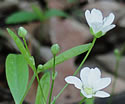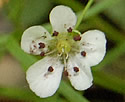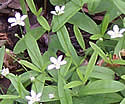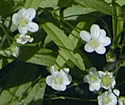Moehringia lateriflora (Bluntleaf Sandwort)
| Also known as: | Grove Sandwort |
|---|---|
| Genus: | Moehringia |
| Family: | Caryophyllaceae (Pink) |
| Life cycle: | perennial |
| Origin: | native |
| Habitat: | part shade, shade; open woods, woodland edges, meadows |
| Bloom season: | May - June |
| Plant height: | 2 to 8 inches |
| Wetland Indicator Status: | GP: FACU MW: FACU NCNE: FACU |
| MN county distribution (click map to enlarge): |  |
| National distribution (click map to enlarge): |  |
Pick an image for a larger view. See the glossary for icon descriptions.
Detailed Information
Flower: 

![[photo of flowers]](/udata/r9ndp23q/pd/moehringia-lateriflora-8-t.jpg) 1 to 5 stalked flowers in a branching cluster at the tip of the stem. Flowers are ¼ to 3/8 inch across, 5 oblong-elliptic white petals and 10 white-tipped stamens surrounding a greenish ovary with 3 spreading styles in the center. The stamen tips may turn black with age. Behind the flower are 5 light green sepals that have pointed tips and extend to about 1/3 the length of the petals. At the base of a flower stalk is a pair of tiny scale-like bracts.
1 to 5 stalked flowers in a branching cluster at the tip of the stem. Flowers are ¼ to 3/8 inch across, 5 oblong-elliptic white petals and 10 white-tipped stamens surrounding a greenish ovary with 3 spreading styles in the center. The stamen tips may turn black with age. Behind the flower are 5 light green sepals that have pointed tips and extend to about 1/3 the length of the petals. At the base of a flower stalk is a pair of tiny scale-like bracts.
Leaves and stem: 

![[photo of leaves]](/udata/r9ndp23q/pd/moehringia-lateriflora-75983-t.jpg) Leaves are 1 to 1½ inches long and 1/8 to 1/3 inch wide, oblong to broadly elliptic, toothless, minutely hairy around the edges and midvein on the underside, blunt or rounded at the tip, and stalkless. Attachment is opposite with leaf pairs at right angles to the pair above and below. Stems are very slender and delicate, typically branched, covered in very short hairs, and mostly prostrate but rising at the tip (decumbent), sometimes ascending.
Leaves are 1 to 1½ inches long and 1/8 to 1/3 inch wide, oblong to broadly elliptic, toothless, minutely hairy around the edges and midvein on the underside, blunt or rounded at the tip, and stalkless. Attachment is opposite with leaf pairs at right angles to the pair above and below. Stems are very slender and delicate, typically branched, covered in very short hairs, and mostly prostrate but rising at the tip (decumbent), sometimes ascending.
Fruit: 
Fruit is a nearly round capsule, about 1/8 inch long, containing 1 to a few tiny, black seeds, though not all flowers produce fruit.
Notes:
Blunt-leaf Sandwort seems to spread primarily vegetatively through rhizomes, often forming a dense tangle of plants. I was steward for this species for a few years at Wild River State Park and only collected about 4 seeds between the two known sites in all that time. The seed capsules rarely developed fruit and I observed the same at two locations in Ramsey County as well. A very similar species is the rare Large-leaved Sandwort (Moehringia macrophylla), which (as its name suggests) has larger leaves up to 2 inches long, sepals at least half as long as the petals, and is a more erect plant.
Native Plant Nurseries, Restoration and Landscaping Services ↓
More photos
 Blunt-leaf Sandwort plant
Blunt-leaf Sandwort plant flowers with black anthers
flowers with black anthers a patch of Bluntleaf Sandwort
a patch of Bluntleaf Sandwort a dense tangle of plants
a dense tangle of plants
Photos by K. Chayka taken at Wild River State Park, Chisago County, and Long Lake Regional Park, Ramsey County. Photos courtesy Peter M. Dziuk taken in Anoka and Washington counties.
Comments
Have you seen this plant in Minnesota, or have any other comments about it?
on: 2010-05-21 07:58:48
I only spotted a couple of these in Whitewater high above the river on south bluff. Ideal conditions with the bloom slightly wider than a half inch.
on: 2010-05-21 10:41:36
I haven't seen it with flowers that large before, only up to about 3/8 inch. Soil conditions or other environmental factors probably have something to do with the size.
on: 2011-05-15 09:39:37
One small patch, blooming on 05/15/11
on: 2022-06-05 01:02:14
Found a little clump of these blooming on a shady hillside today. They're quite pretty.






